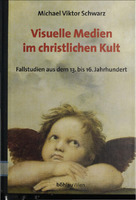Visuelle Medien im christlichen Kult
Fallstudien aus dem 13. bis 16. Jahrhundert
| dc.contributor.author | Schwarz, Michael Viktor | |
| dc.date.accessioned | 2015-12-31 23:55:55 | |
| dc.date.accessioned | 2020-01-29 16:09:11 | |
| dc.date.accessioned | 2020-04-01T14:30:46Z | |
| dc.date.available | 2020-04-01T14:30:46Z | |
| dc.date.issued | 2002 | |
| dc.identifier | 574817 | |
| dc.identifier | OCN: 606869338 | en_US |
| dc.identifier.uri | http://library.oapen.org/handle/20.500.12657/33078 | |
| dc.description.abstract | The concepts of art history were developed in the nineteenth century. This can inhibit dialogue with neighbouring disciplines. The concept “medium”, which belongs to the late twentieth century, can provide assistance and connect the argument of art history to the contemporary state of consciousness at least in the cultural sciences dealing with communication. At the centre of the book lie questions of the use and effect of objects. Dealing with a series of high-ranking art works, an observational method is practised that is both historically founded and compatible with modern discourses. The six case studies address the Naumburg Stifterfiguren, Pietro Lorenzetti’s frescos in Assisi, the Parament of Narbonne, the tomb of Archbishop Chichele in Canterbury, Raphael’s Sistine Madonna in Dresden, and the self-portraits of Anton Pilgram in St Stephen’s Church in Vienna. | |
| dc.language | German | |
| dc.subject.classification | thema EDItEUR::A The Arts::AG The Arts: treatments and subjects::AGA History of art | en_US |
| dc.subject.other | Art history | |
| dc.subject.other | medium | |
| dc.subject.other | liturgy | |
| dc.subject.other | Kunstgeschichte | |
| dc.subject.other | Medium | |
| dc.subject.other | Liturgie | |
| dc.subject.other | Kult | |
| dc.subject.other | Medienkunst | |
| dc.title | Visuelle Medien im christlichen Kult | |
| dc.title.alternative | Fallstudien aus dem 13. bis 16. Jahrhundert | |
| dc.type | book | |
| oapen.abstract.otherlanguage | Die Konzepte der Kunstgeschichte sind im 19. Jahrhundert entwickelt worden. Das erschwert den Dialog mit vielen Nachbardisziplinen. Das Konzept "Medium", das dem ausgehenden 20. Jahrhundert angehört, soll dem abhelfen und das Argument der Kunstgeschichte mit dem gegenwärtigen Bewusstseinsstand mindestens in denjenigen Kulturwissenschaften verknüpfen, die sich mit Kommunikation befassen. Im Mittelpunkt des Buches stehen die Fragen nach Gebrauch und Wirkung der Objekte. Eingeübt wird eine Betrachtungsweise von hochrangigen Kunstwerken, die sowohl historisch fundiert als auch modernen Diskursen kompatibel ist. Die sechs Fallstudien befassen sich mit den Naumburger Stifterfiguren, Pietro Lorenzettis Fresken in Assisi, dem Parament von Narbonne, dem Grabmal des Erzbischofs Chichele in Canterbury, Raphaels Sixtinischer Madonna in Dresden, und den Selbstbildnissen Anton Pilgrams in der Wiener Stephankirche. | |
| oapen.identifier.doi | 10.26530/oapen_574817 | |
| oapen.relation.isPublishedBy | af16fd4b-42a1-46ed-82e8-c5e880252414 | * |
| oapen.relation.isFundedBy | 26ae1657-c58f-4f1d-a392-585ee75c293e | |
| oapen.relation.isbn | 3205993241 | |
| oapen.collection | Austrian Science Fund (FWF) | |
| oapen.imprint | Böhlau | |
| oapen.pages | 330 | |
| oapen.grant.number | D 3326 | |
| oapen.remark.public | Relevant Wikipedia pages: Kult - https://de.wikipedia.org/wiki/Kult; Liturgie - https://de.wikipedia.org/wiki/Liturgie; Medienkunst - https://de.wikipedia.org/wiki/Medienkunst | |
| oapen.identifier.ocn | 606869338 |

